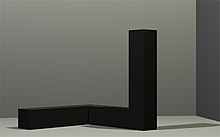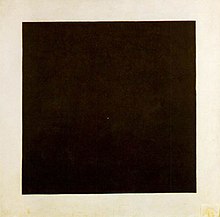


In contrast to the Abstract Expressionists, Minimalists were influenced by composers John Cageand LaMonte Young, poet William Carlos Williams, and the landscape architect Frederick Law Olmsted. They very explicitly stated that their art was not self-expression, in opposition to the previous decade's Abstract Expressionists. In general, Minimalism's features included geometric, often cubic forms purged of much metaphor, equality of parts, repetition, neutral surfaces, and industrial materials.
Robert Morris, an influential theorist and artist, wrote a three part essay, "Notes on Sculpture 1-3", originally published across three issues of Artforum in 1966. In these essays, Morris attempted to define a conceptual framework and formal elements for himself and one that would embrace the practices of his contemporaries. These essays paid great attention to the idea of the gestalt - "parts... bound together in such a way that they create a maximum resistance to perceptual separation." Morris later described an art represented by a "marked lateral spread and no regularized units or symmetrical intervals..." in "Notes on Sculpture 4: Beyond Objects", originally published in Artforum, 1969, continuing to say that "indeterminacy of arrangement of parts is a literal aspect of the physical existence of the thing." The general shift in theory of which this essay is an expression suggests the transitions into what would later be referred to as Postminimalism.
One of the first artists specifically associated with Minimalism was the painter, Frank Stella, whose early "stripe" paintings were highlighted in the 1959 show, "16 Americans", organized by Dorothy Miller at the Museum of Modern Artin New York. The width of the stripes in Frank Stellas's stripe paintings were determined by the dimensions of the lumber, visible as the depth of the painting when viewed from the side, used to construct the supportive chassis upon which the canvas was stretched. The decisions about structures on the front surface of the canvas were therefore not entirely subjective, but pre-conditioned by a "given" feature of the physical construction of the support. In the show catalog, Carl Andre noted, "Art excludes the unnecessary. Frank Stella has found it necessary to paint stripes. There is nothing else in his painting." These reductive works were in sharp contrast to the energy-filled and apparently highly subjective and emotionally-charged paintings of Willem de Kooning or Franz Kline and, in terms of precedent among the previous generation of abstract expressionists, leaned more toward less gestural, often somber coloristic field paintings of Barnett Newmanand Mark Rothko. Although Stella received immediate attention from the MOMA show, artists like Kenneth Noland, Ralph Humphrey, Robert Motherwell and Robert Ryman had begun to explore stripes, monochromatic and Hard-edge formats from the late 50s through the 1960s.[5]
Because of a tendency in Minimalism to exclude the pictorial, illusionistic and fictive in favor of the literal, there was a movement away from painterly and toward sculptural concerns. Donald Judd had started as a painter, and ended as a creator of objects. His seminal essay, "Specific Objects" (published in Arts Yearbook 8, 1965), was a touchstone of theory for the formation of Minimalist aesthetics. In this essay, Judd found a starting point for a new territory for American art, and a simultaneous rejection of residual inherited European artistic values. He pointed to evidence of this development in the works of an array of artists active in New York at the time, including Jasper Johns, Dan Flavin and Lee Bontecou. Of "preliminary" importance for Judd was the work of George Ortman [1], who had concretized and distilled painting's forms into blunt, tough, philosophically charged geometries. These Specific Objects inhabited a space not then comfortably classifiable as either painting or sculpture. That the categorical identity of such objects was itself in question, and that they avoided easy association with well-worn and over-familiar conventions, was a part of their value for Judd.
In a much more broad and general sense, one might, in fact, find European roots of Minimalism in the geometric abstractions painters in theBauhaus, in the works of Piet Mondrian and other artists associated with the movement DeStijl, in Russian Constructivists and in the work of the Romanian sculptor Constantin Brâncuşi.
Piet Mondrian, Composition No. 10, 1939-42, oil on canvas, 80 x 73 cm, private collection.
This movement was heavily criticised by high modernist formalist art critics and historians. Some anxious critics thought Minimalist art represented a misunderstanding of the modern dialectic of painting and sculpture as defined by critic Clement Greenberg, arguably the dominant American critic of painting in the period leading up to the 1960s. The most notable critique of Minimalism was produced by Michael Fried, a Greenbergian critic, who objected to the work on the basis of its "theatricality". In Art and Objecthood (published in Artforum in June 1967) he declared that the Minimalist work of art, particularly Minimalist sculpture, was based on an engagement with the physicality of the spectator. He argued that work like Robert Morris's transformed the act of viewing into a type of spectacle, in which the artifice of the act observation and the viewer'sparticipation in the work were unveiled. Fried saw this displacement of the viewer's experience from an aesthetic engagement within, to an event outside of the artwork as a failure of Minimal art. Fried's opinionated essay was immediately challenged by artist Robert Smithson in a letter to the editor in the October issue of Artforum. Smithson stated the following: "What Fried fears most is the consciousness of what he is doing--namely being himself theatrical."
Other Minimalist artists include: Richard Allen, Walter Darby Bannard, Larry Bell, Ronald Bladen,Mel Bochner, Norman Carlberg, Erwin Hauer, Dan Flavin, Sol LeWitt, Brice Marden, Agnes Martin,Jo Baer, John McCracken, Paul Mogensen, David Novros, Ad Reinhardt, Fred Sandback, Richard Serra, Tony Smith, Robert Smithson, and Anne Truitt.
Ad Reinhardt, actually an artist of the Abstract Expressionist generation, but one whose reductive nearly all-black paintings seemed to anticipate minimalism, had this to say about the value of a reductive approach to art: "The more stuff in it, the busier the work of art, the worse it is. More is less. Less is more. The eye is a menace to clear sight. The laying bare of oneself is obscene. Art begins with the getting rid of nature."









